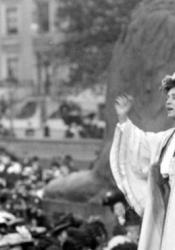Emmeline Pankhurst and suffragette involvement in the Conciliation Bills
Emmeline Pankhurst was the owner of a women’s shop called Emerson’s. Emmeline Goulden married Dr. R. M. Pankhurst who was also an advocate for the rights of women which furthered her interest in women’s rights. Emmeline Pankhurst established The Women’s Social and Political Union in 1903. The Women’s Social and Political Union was a militant organization in the years before World War I with women smashing store windows, going to parliament meetings to shout, “Votes for women” and other political protests. This is interesting in relation to Pankhurst because she advocated the smashing of store windows while she was a shop owner. Pankhurst owning a shop also put her in
The book review entitled “A Conservative Revolutionary: Emmeline Pankhurst (1857-1928)” gives a detailed account of how Emmeline Pankhurst was described in June Purvis’s biography of her. Purvis describes Pankhurst in very masculine terms such as “A Reel of Steel” while other articles describe her as the exact ideal of beauty in England in Pankhurst’s time. This article is important because it gives background on Emmeline Pankhurst and discusses the images other articles made of Emmeline Pankhurst. This article discusses her life and what she was really like behind all the media images created about her. The article “The Most Prominent Suffragette” gives a look at the biography written by Purvis and talks about Pankhurst’s life in addition to the obstacles she faced in fighting for women’s rights. In this article, she points out some important flaws in the biography of Pankhurst such as a lack of information on her views of race. The article “Model Citizens and Millenarian Subjects: Vorticism, Suffrage, and London's Great Unrest” is about representation of suffragettes but shows a more In-depth view of the protests that Emmeline Pankhurst’s organization The Women’s Social and Political Union carried out in 1910. The article on page five goes into detail about the types of protests that the suffragettes used to gain attention for their cause. The article “The 1910s: ‘We have
A Conservative Revolutionary: Emmeline Pankhurst (1857-1928)
ROLLYSON, CARL. “A CONSERVATIVE REVOLUTIONARY: EMMELINE PANKHURST (1857-1928).” The Virginia Quarterly Review, vol. 79, no. 2, 2003, pp. 325–334. JSTOR, JSTOR, www.jstor.org/stable/26440996.
The Most Prominent Suffragette
Winslow, Barbara. “The Most Prominent Suffragette.” The Women's Review of Books, vol. 20, no. 8, 2003, pp. 13–14. JSTOR, JSTOR, www.jstor.org/stable/4024138.
Model Citizens and Millenarian Subjects: Vorticism, Suffrage, and London's Great Unrest
Richards, Jill. “Model Citizens and Millenarian Subjects: Vorticism, Suffrage, and London's Great Unrest.” Journal of Modern Literature, vol. 37, no. 3, 2014, pp. 1–17. JSTOR, JSTOR, www.jstor.org/stable/10.2979/jmodelite.37.3.1.
The 1910s: ‘We have sanitised our history of suffragettes
https://www.theguardian.com/lifeandstyle/2018/feb/06/1910s-suffragettes-suffragists-fern-riddell
Riddell, Fern. “The 1910s: 'We Have Sanitised Our History of the Suffragettes'.” The Guardian, Guardian News and Media, 6 Feb. 2018, www.theguardian.com/lifeandstyle/2018/feb/06/1910s-suffragettes-suffragi....
Lloyd George
https://www.britannica.com/biography/David-Lloyd-George
Robert Norman William Blake, Baron Blake. “David Lloyd George.” Encyclopædia Britannica, Encyclopædia Britannica, Inc., 19 Mar. 2018, www.britannica.com/biography/David-Lloyd-George.

